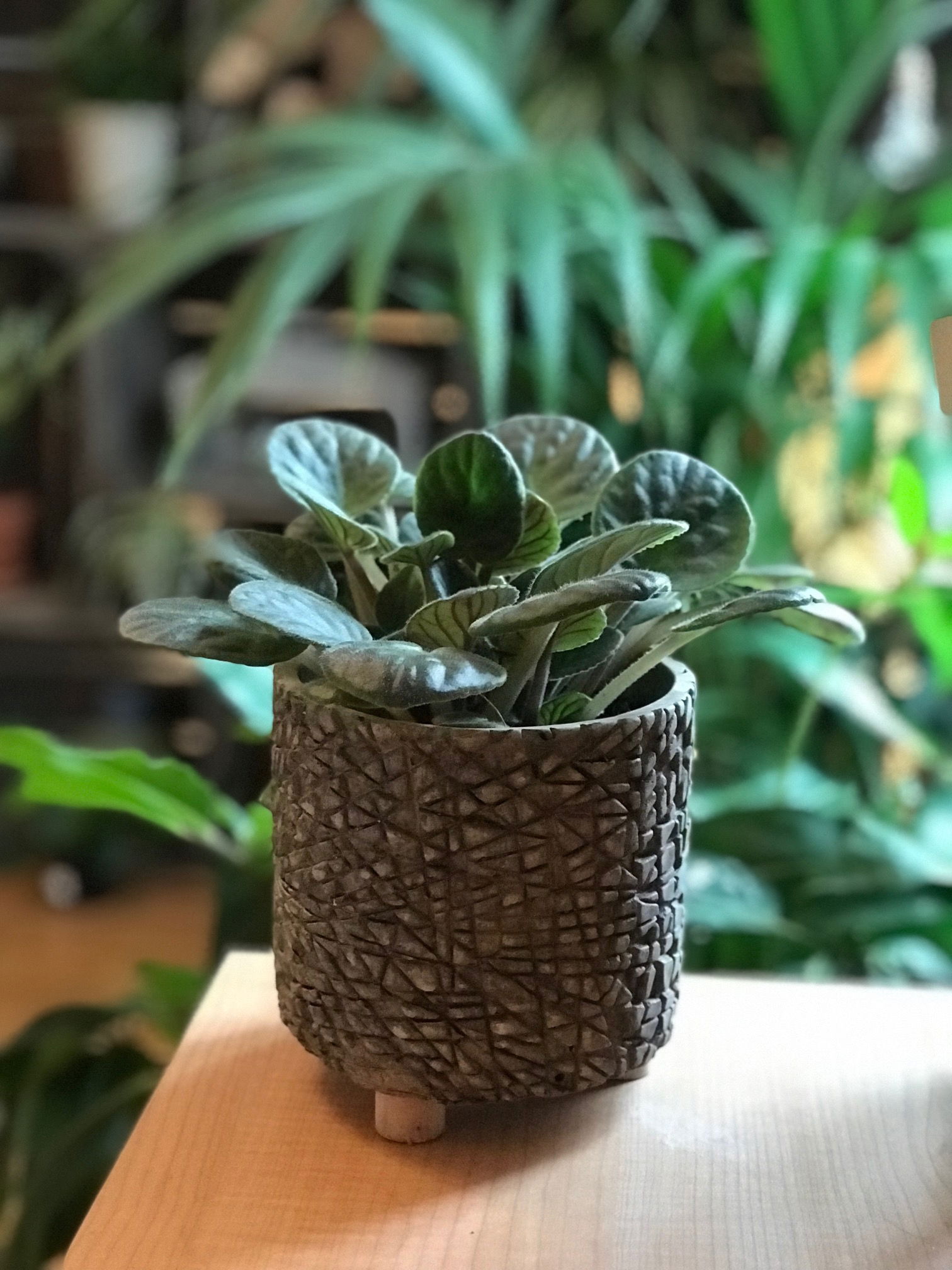
Streptocarpus ionanthus - Formally known as 'Saintpaulia ionantha'.
Contents
- Top Tips
- Location, Water, Humidity & Fertilisation
- Dormancy Care & Annual Flowers
- Common Issues
- Origins, Temperature, Propagation, Repotting & Toxicity.
Need the answer to a specific plant query? Book a 1-to-1 video call with THE HOUSEPLANT DOCTOR™, the website's friendly author, to overcome and address your niggling problem! Available on iMessage, WhatsApp, Facebook Messenger & more.
Top Tips & Info
- Care Difficulty - East to Moderate
- African Violets will require bright, sunless windowsill for best growth. Never place this plant more than 1.5m away from a windowsill, unless it's below an LED growlight.
- Only rehydrate the soil once its leaves feel a little floppy/soft when touched. While the plant's foliage is plump and hard, you won't need to water its soil.
- Throughout the year, use either a 'Houseplant' or 'Orchid'-labelled fertiliser every third water - even during the winter months.
- Repot your African Violet every three to four years with a 'Houseplant' potting mix and the next size pot with drainage holes. Remember: A potbound specimen is more likely to flower each year when its root system is slightly restricted (due to stress-response).
- Keep an eye out for Mealybugs that'll inhabit the cubbyholes of the foliage and flowers.
Location & Light - 🔸🔸
Provide a location that offers bright, indirect light away from the risk of sun-scorch. Although a splash of morning or evening sunlight is accepted with this species, the risk of dehydration and terminal damage on its foliage is too risky for non-acclimated specimens.
We'd recommend situating yours within two metres of a window or within a north-facing windowsill as long as there isn't an operation radiator directly below it.
Water - 🔸🔸
Water an African Violet is very easy. They prefer being kept on the drier side to life, so always keep this in mind. You should only rehydrate the soil once its foliage feels soft/floppy when touched. While the leaves are plump and hard, you must leave the plant alone - don't water!
Under-watering symptoms include rapid flower loss and dry, crisping leaves - these issues are commonly down to forgetfulness, too much sunlight or high temperatures. Even though an under-watered Violet is far better than a soggy one, never allow the soil to fully dry out for too long as this could reduce the chance of new buds forming. Over-watering symptoms include rotting lower leaves, yellowing leaves, a loss of buds or flowers and root or crown rot. Allow most of the soil to dry out in between waters and do not allow a pool of standing water accumulate beneath the pot as failure to keep its environment relatively dry will result in plant death.
Note: Over-watering and root rot is extremely common with African Violets grown in dark areas (more than 2m from a window) and/or temperatures below 18℃ (66℉).
Humidity - 🔸
Average room humidity is enough to satisfy this plant, as long as you don't live in an overly-dry climate. Never situate it within a few metres of an operating radiator due to the enriched chance of browning leaf-tips. If you are indeed worried about dry air, create a humidity tray to provide a moist and stable environment for your plant, which will also have the added benefit of slowing the rates of drying soil!
Fertilisation - 🔸🔸
Fertilise your African Violet once every third water, all year round. The best product to use is a 'Houseplant' or 'Orchid' labelled feed to provide the correct amount of nutrients the plant will need.
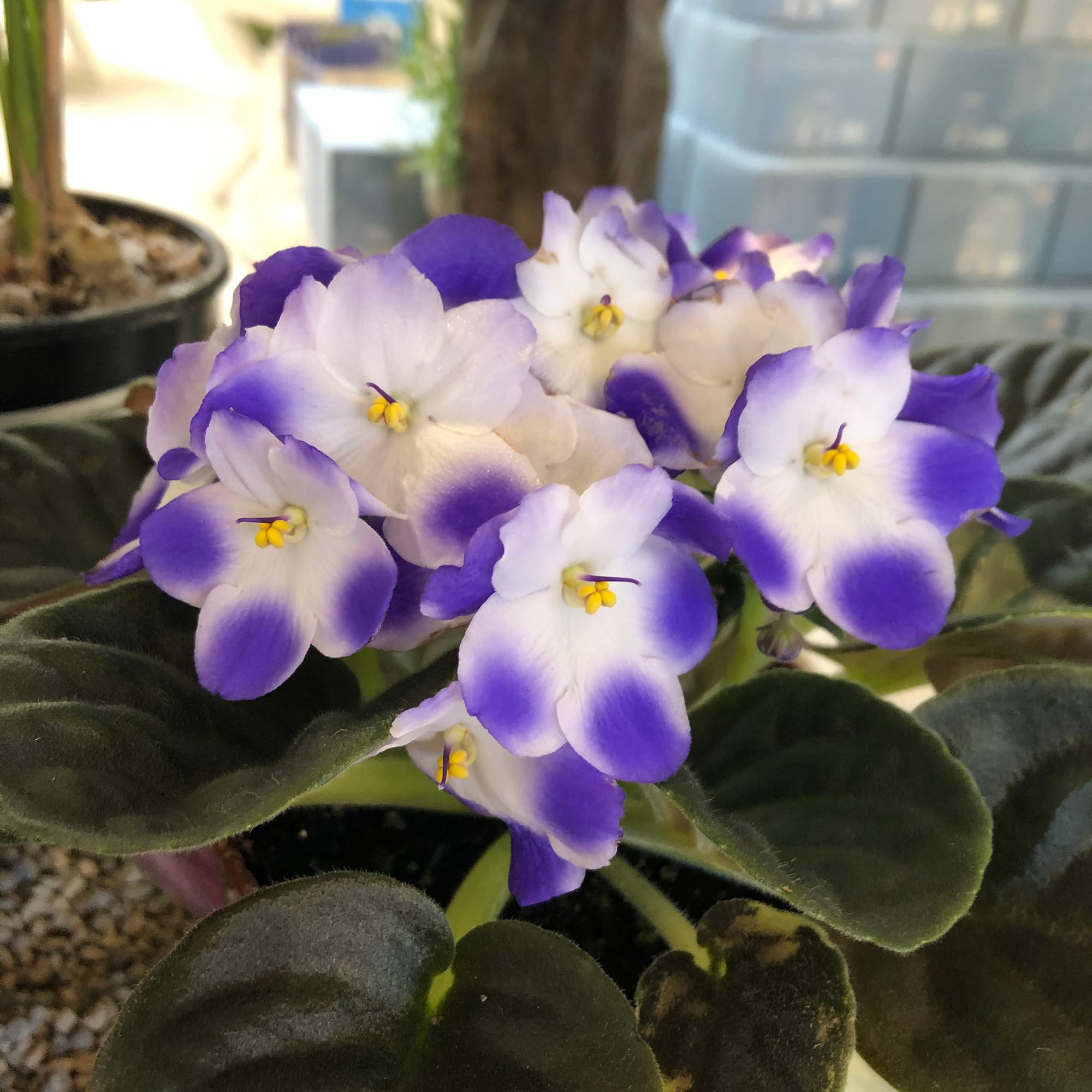 Streptocarpus ionanthus
Streptocarpus ionanthus
Dormancy Care & Annual Flowers
Provide a bright, and cool autumn and winter period around 15℃ (59℉) to reinforce its dormancy. Keep the roots pot-bound to add further stress onto the specimen, which in turn will heighten the chance of flowering. Blooms will generally appear in the spring and summer months, during active growth.
The following steps should be taken from early autumn until the end of winter.
Sunlight & Location
Be sure to provide a bright location with no direct sunlight; those kept on a north, east or west-facing window is most happy. Avoid deep shade and the use of artificial lighting at night or locations that boast temperatures higher than 18℃ (64℉).
Hydration
Reduce waters so that at least half of the soil becomes dry. It's essential to keep them on the drier side to life, as they'll think that hard times are ahead and therefore will need to pass its genes on to the next generation.
Occasional Feeds
During the autumn and winter, fertilisation should be performed at monthly intervals with a 'Houseplant' or 'Streptocarpus' labelled feed. While the flowers are budding or in bloom, use a Tomato fertiliser to provide fortnightly nourishment of potassium.
Reduce Everything
This is to remind you that everything needs to be reduced, except the light levels.
Temperature
This is the most significant step; reduce the temperature down by around 5℃ compared to the summertime or place in a room that's between 14º - 17℃ (57º - 62℉). You'll be at a significant disadvantage if the ambient temperature is kept constant throughout the year, as African Violets will only respond in locations that have daily fluctuations of around 5℃. Never exceed the minimum temperature as it may lead to plant death or yellowed foliage at a bare minimum. If these steps are followed successfully, you could see a show of blooms in the following summer - but remember, dealing with nature may not always provide the results you'd relish.
Common Issues with African Violets
Green Aphids are also a common issue - small, lime-coloured critters can easily blend in with the foliage, thus leading to rapid infestations. They are most likely to infest the juvenile leaves or the flowers and stalks themselves. Each Aphid can lay up to five or six eggs per day, meaning that an infestation can develop rapidly. The best way to prevent an attack before it becomes a threat is by keeping the windows and doors shut, with regular pest inspections on newly-purchased specimens. Click here to learn more about eradicating Aphids.

This is an African Violet (Saintpaulia) that was in the reduced section in a local garden centre. There is nothing wrong with this plant except that it's missing a few leaves. Ensure the plant is kept in a bright, sunless windowsill and water once the leaves have softened over.
Mould developing on the soil means two things - too little light and over-watering. Despite the harmlessness, it'll prove unsightly to most gardeners and is therefore removed once known. To remove, replace the top two inches of the soil for a fresh batch of 'Houseplants' compost. Either increase the amount of light received or reduce the frequency of watering.
A lack of flowers is caused by an insufficient dormancy period, where the temperatures are kept more or less the same over the year. Reduce the temperature by a couple of degrees over the autumn and winter months, along with fewer irrigations to ensure a well-spent dormancy. As spring arrives, the natural temperature will begin to increase, with this is being the perfect time to increase waters and fertilisation. Remember, the warmer the summer days are, the more likely a specimen is to reflower.
While we're on the subject, if you'd like to prolong the flowering period, use a fertiliser high in potassium to promote longer lasting flowers; Streptocarpus Food is an excellent choice. Other tips to extend this period are: avoid temperature fluctuations and droughts, maintain good humidity and place in a well-lit room with little to no direct sunlight.
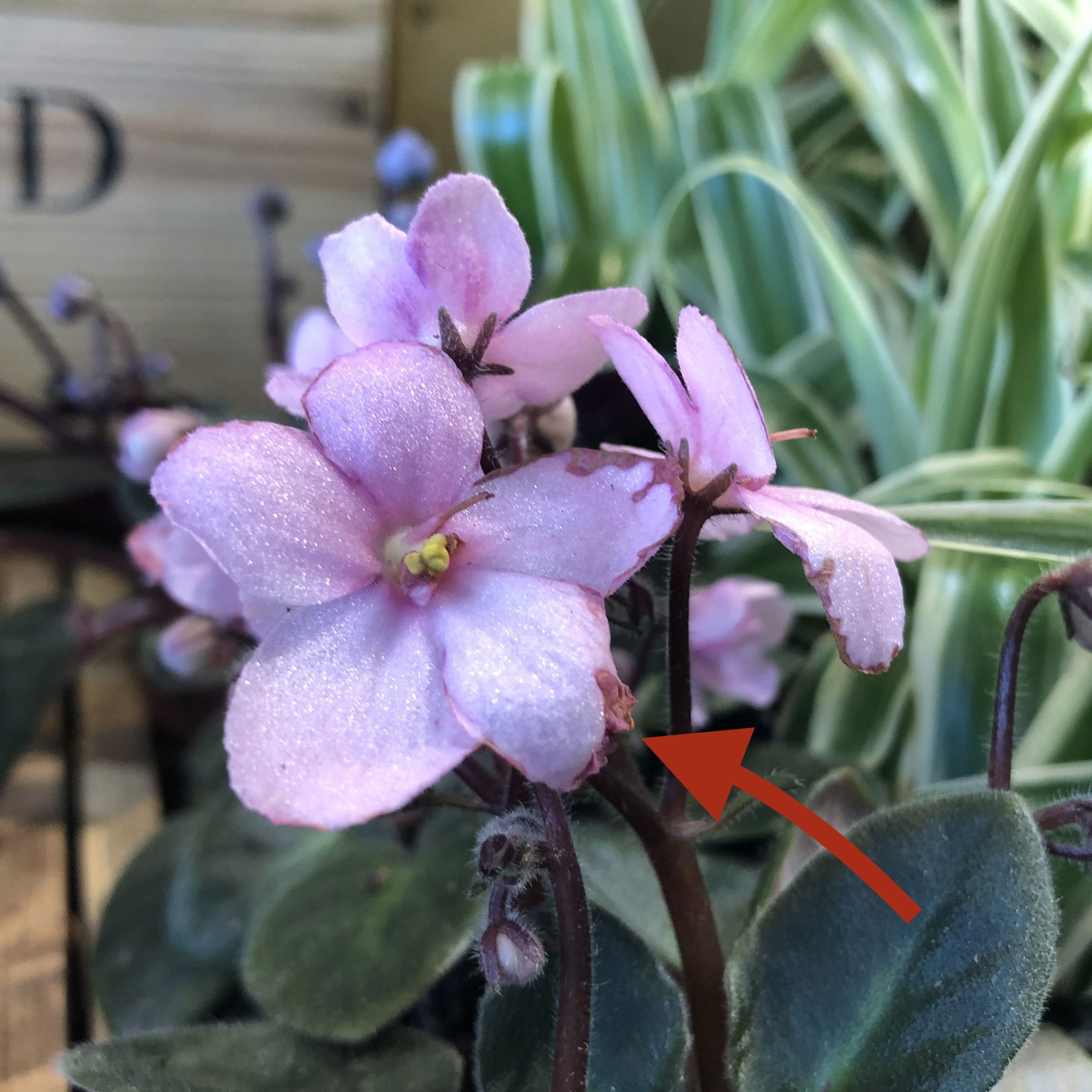 When the flower's petal edge begins to curl, it means there'll only be around two more weeks before it'll die. Remember to prune spent blooms to encourage further flowering!
When the flower's petal edge begins to curl, it means there'll only be around two more weeks before it'll die. Remember to prune spent blooms to encourage further flowering!
Failed propagated leaf cuttings - There are several reasons why the cuttings haven't rooted well, including: the time of year (spring or summer is best), its size (leaves that are in the middle are most suitable for propagation), poor growing conditions (replace water weekly for water-propagated cuttings, and avoid over-watering for soil-grown plants), and its growing environment (a bright sunless windowsill and warmth is important).
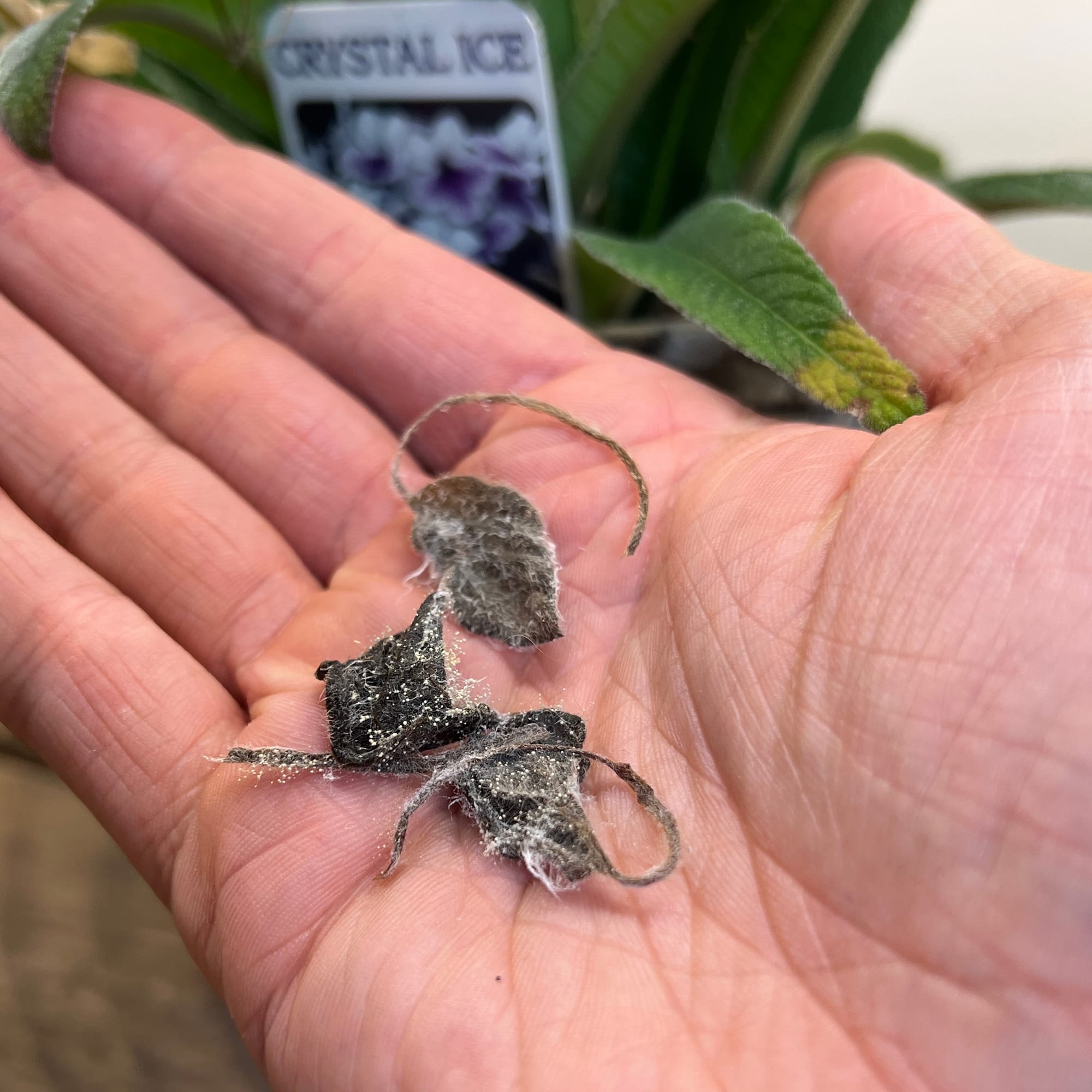
Leaves that turn grey and mouldy must be removed as this could spread across the plant. Commonly referred to as 'Botrytis' or 'Grey Mould', the disease will be exacerbated when your African Violet is placed in a cold, darker area of the house. Make sure it's kept in the warmest room to avoid this returning.
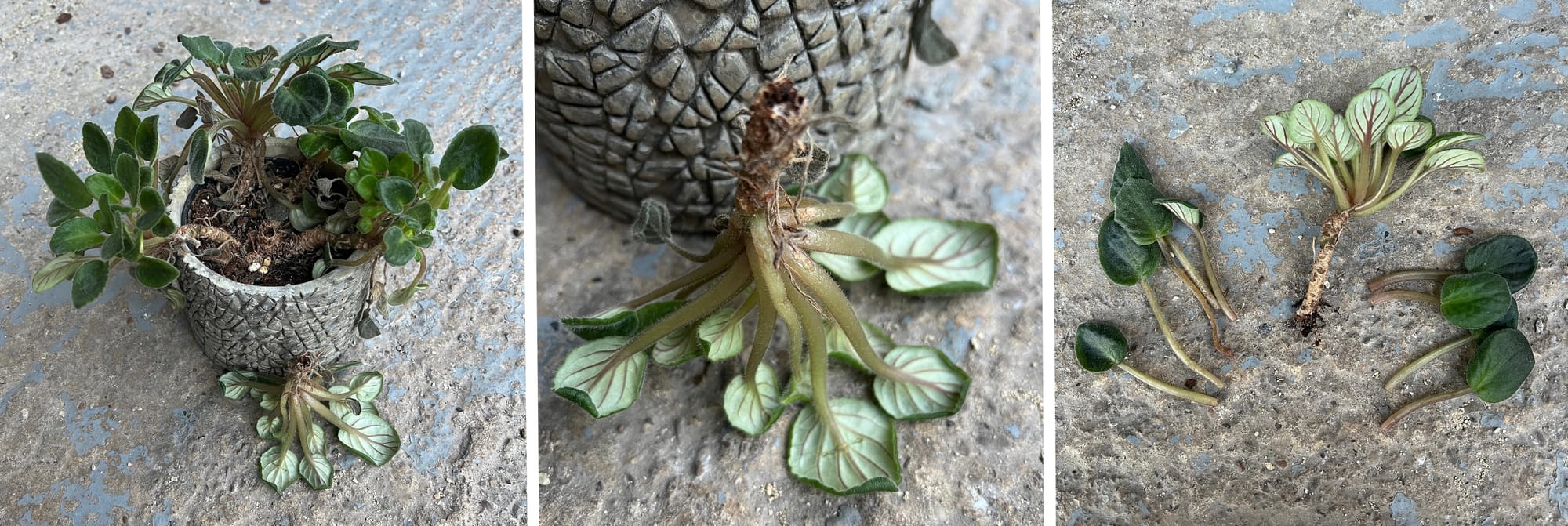
If your African Violet's stem begins to 'flop' or rot at the base, this is most likely to be root rot. Especially if the plant has mouldy leaves (like the image above), you must take stem cuttings to restart the root system from scratch. Scroll down to the image below 'Propagation' to see our successful stem cutting! what can I do if my African violet streptocarpus saintpaulia rots at the base dies
Finally, small flies hovering around your plant or soil is entirely natural and may just indicate you're watering a little too often. Fungus Gnats are a common 'pest' with African Violets due to their dependency to reliable soil moisture, but won't pose any risk to the plant's health. Simply replace the top quarter of the plant's potting mix for a fresh batch of 'Houseplant' labelled compost, typical found at most garden centres. Remember to reduce the frequency of waters to avoid this occurring again!
Origins
'Saintpaulia' is a redundant genus in the Gesneriad family, which held around ten species originating from central to south Africa. Within the last decade, all of the species have now been reclassified in neighbouring Streptocarpus. Saintpaulia was first penned in 1892 and named in honour of the district commissioner of Tanga (Kenya), Walter von Saint Paul-Illaire. John Lindley first described Streptocarpus in 1828, using the Greek words' streptos' and 'karpos' in reference to the twisted seedpods when fully matured.
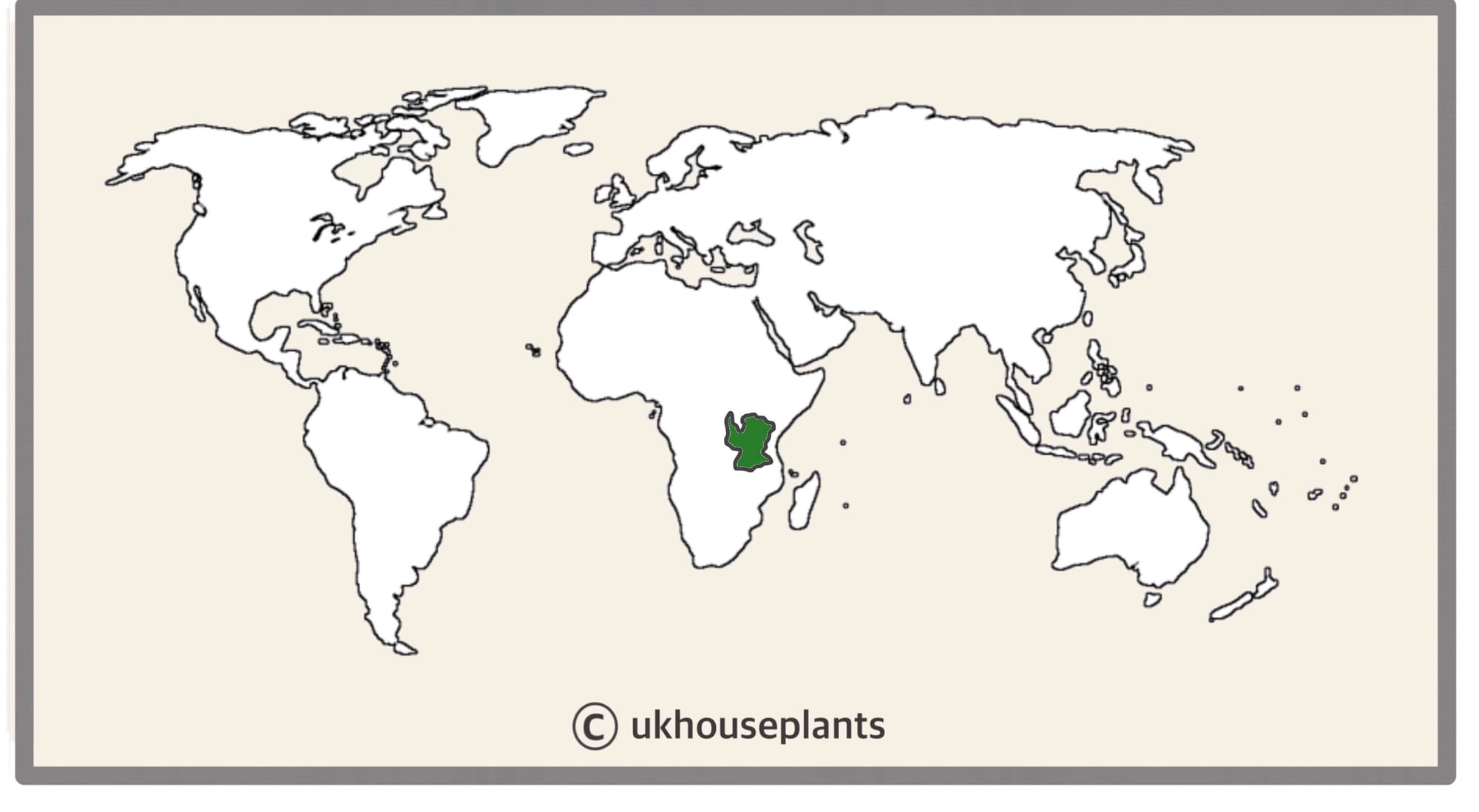 The Distribution of the most popular 'Saintpaulia', the Streptocarpus ionanthus.
The Distribution of the most popular 'Saintpaulia', the Streptocarpus ionanthus.
Temperature
10° - 30°C (50° - 86°F)
H1b (Hardiness Zone 12) - Can be grown outdoors during the summer in a sheltered location with temperatures above 10℃ (50℉), but is fine to remain indoors, too. If you decide to bring this plant outdoors, don't allow it to endure any direct sunlight as it may result in sun-scorch and dehydration. Regularly keep an eye out for pests, especially when re-introducing it back indoors.
Spread
Up to 20cm in height & 35cm in width. The ultimate height will take around five years to achieve.
Pruning & Maintenance
Remove yellow or dying leaves, and plant debris to encourage better-growing conditions. While pruning, always use clean utensils or shears to reduce the chance of bacterial and fungal diseases. Never cut through yellowed tissue as this may cause further damage in the likes of diseases or bacterial infections. Remember to make clean incisions as too-damaged wounds may shock the plant, causing weakened growth and a decline in health.
Propagation
Via Seed, Division, Leaf Cuttings and Stem Cuttings.
Basal Offset Division (Easy) - The ideal time to divide is during the repotting period. Gently tease away some of the soil, and separate a few basal offsets which have its own root system. Place the plantlet in moist 'Houseplant' compost and be sure you don't submerge its leaves or basal cubbyhole into the soil. Keep the soil relatively moist and place it in a bright, indirect location to avoid the risk of dehydration (a common trait of death). This method can be relatively straightforward; however, be mindful of transplant shock, whereby its root systems are severely over-touched, which may result in excessive wilting.
Serrated Leaf Cuttings (Easy to Moderate) - This method of propagation is by far the most enjoyable, and the easiest way to identically duplicate the original plant. High levels of 'Cytokinin' found in the leaves enable them to root and produce new growths along its serrated wound. Leaves that are at least 5cm long and part of an established plant are most successful. Use clean scissors and cautiously cut close to the main stem, empathising the simpleness of the wound. Cut the loose leaf in half vertically, so that the its width is reduced. Next, dip the wounds in a water/bleach solution (9 parts water, 1 part household bleach) to promote sterility. (Only use if you're an adult, following safety recommendations of the manufacturer). While using a seed tray or Bonsai dish and 'Houseplant' labelled potting mix, place the leaf sections wound-down in around 1cm (0.3 inches) into the soil. Apply slight pressure around the base of the leaf for extra stability with the sounding soil. Provide a bright, indirect setting with temperatures above 18℃ (64℉) and keep the pot in a sealed transparent bag with multiple small holes to maintain high humidity. Open the bag every couple of days to monitor how the cuttings are performing and to allow fresh air to circulate. Remove any rotten or yellowing material as it can spread onto neighbouring leaves. If propagation is successful, you should start to see new shoots surfacing the soil line after six to eight weeks. Keep the growing conditions the same, and once the shoots are big enough to pot on (four leaves on each growth), they can be potted up in 'Houseplant' Compost with 5cm (2 inch) pots. Repot as necessary and care in the same way as adult specimens with the care tips written at the top.
Whole Leaf Cuttings (Easy) - Instead of cutting the leaf into several sections (see image above), you can even keep it whole (like the image above) by placing the wound-end in a small glass of water to root. Once the roots are 2cm in length (1 inch), pot it up into a 7cm plastic pot with 'Houseplant' labelled potting mix. Whilst the leaf is rooting in the soil, be sure to cut the leaf in half horizontally, so that the total length of is reduced by half. Don't cut along the midrib. Keep the potted leaf in a transparent bag with a few holes and provide a indirect location with regular soil moisture. Once the third baby leaf emerges, you can remove the bag and treat as a mature specimen.
Stem Cuttings (Easy, Image Below) - This method should only be done if the plant is suffering from basal or root rot. Simply cut the stem horizontally above the soil line to free the stem/foliage from its root system. With the bare pruned end, cut off the bottom fifth of the leaves to reduce the overall size of the plant - feel free to propagate these leaves via the method above. Place the bare stem in a jar of water and pot up once the roots' length are 5cm (2 inches) in a 7cm pot with 'Houseplant' potting mix. Maintain reliable soil moisture and provide a bright, indirect windowsill for three months until the plant can be treated as a mature specimen with the info mentioned above in ‘Top Tips’. Feed every three waters.
 Taking whole stem cuttings is a great, fast way to save the plant from issues of basal or root rot.
Taking whole stem cuttings is a great, fast way to save the plant from issues of basal or root rot.
Flowers
African Violets are perennial, with flowers typically appearing in the spring and summer months. The individual flower can last up to six weeks, with the overall show can last two to three months. It's heavily important not to allow moisture to sit on the flowers' cubbyholes, as Botrytis Petal-Blight is a serious threat among Violet growers. Keep the foliage and flowers dry when watering!
Repotting
Repot every three or four years in the spring using a 'Houseplant' potting mix and the next sized pot with adequate drainage holes. African Violets are far better potbound for several years due to the heightened risk of root rot and repotting-issues (like transplant shock) when they are recently repotted. A restricted root system will also help the chance of a yearly show of flowers, too.
Hydrate the plant 24hrs before tinkering with the roots to prevent the risk of transplant shock. For those situated in a darker location, introduce an extra amount of perlite and grit into the deeper portion of the pot to downplay over-watering risks. Click on this link for a detailed step-by-step guide on transplantation, or via this link to learn about repotting with root rot.
Pests & Diseases
Keep an eye out for mealybugs, aphids, scale, fungus gnats, blackfly, vine weevils & root mealybugs that'll locate themselves in the cubbyholes and undersides of the leaves, with the exception of the latter two in the soil. Common diseases associated with these plants are root rot, leaf-spot disease, Botrytis, rust, powdery mildew & southern blight - click here to learn more about these issues.
Toxicity
Not known to be poisonous when consumed by pets and humans. If large quantities are eaten, it may result in vomiting, nausea and a loss of appetite.
Retail Locations
Dobbies, Dibley's Online Store, Online Stores.
Book a 1-to-1 Call with THE HOUSEPLANT DOCTOR™
If you need further advice with your houseplants, book an advice call with ukhouseplants' friendly and expert writer today! This can be done via a video or audio call on most apps, including Facebook, FaceTime & Skype. A ten-minute call costs £5.99 (US$7), or £15.99 for thirty minutes. You can ask multiple questions, including queries on plants, pests, terrariums, repotting advice and anything in between. Please consider supporting this service to keep ukhouseplants thriving!